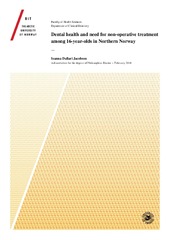| dc.contributor.advisor | Ullbro, Christer | |
| dc.contributor.author | Jacobsen, Ioanna Dallari | |
| dc.date.accessioned | 2018-02-26T16:11:32Z | |
| dc.date.available | 2018-02-26T16:11:32Z | |
| dc.date.issued | 2018-02-16 | |
| dc.description.abstract | Epidemiological data have disclosed a considerable reduction in caries prevalence among children and adolescents in Western countries including Norway for over 40 years. Concomitantly, enamel caries has received increased focus in order to give a better picture of the complete need for dental treatment, non-operative as well as operative. More recently, dental erosive wear seems to be a growing problem among the same age group.
The aims of the present thesis were:
• to determine the prevalence of dentinal caries and the variation in caries prevalence related to selected independent variables (sociodemography, lifestyle) in a sample of 869 16-year-olds from Northern Norway.
• to estimate the prevalence of proximal enamel lesions and the need for non-operative caries treatment.
• to record the quality of dental restorations.
• to study the prevalence, distribution and severity of dental erosion.
The thesis is based on an oral- and general health cross-sectional study (Fit Futures), with an attendance rate of 90%.
The DMFT/S-values were 4.2 / 6.1. The final multivariate regression analysis indicated that use of smokeless tobacco, dental fear, self-rated dental health and proximal enamel caries showed a strong independent association with prevalence of dentinal caries. Only 6 % of the 16-year-olds were completely caries-free. Eighty-four per cent of the participants presented with proximal enamel lesions. A majority of them had either previously restored teeth (35%) or both restored teeth and untreated dentinal caries lesions (34%). Over one third (35%) of the participants with fillings presented with at least one restoration below acceptable quality level. More than one third (38%) of the adolescents showed erosive wear on at least one tooth surface, either limited to the enamel (18%), or extending into the dentine (20%).
Dental caries and erosive wear are challenging conditions among North Norwegian 16-year-olds. The high prevalence of early signs of disease (proximal enamel lesions and cuppings) entails a need for non-operative treatment interventions. The DMFS-score and the high number of 16-year-olds with restorations in need of repair or replacement further indicate the importance of a non-operative treatment strategy in order to reduce the need of traditional restorative care. | en_US |
| dc.description.doctoraltype | ph.d. | en_US |
| dc.description.popularabstract | Statistical data have shown a considerable reduction in caries disease among children and adolescents in Western countries, including Norway, for over 40 years. Recently, diagnosis and treatment of early stages of caries have received increased focus. At the same time, dental erosion seems to be a growing problem among the same age groups.
The present thesis was based on an oral and general health study (Fit Futures) of 869, 16-year-olds from Troms County. The aim of the thesis were to estimate the dental health of the participants with particular focus on caries disease and erosive lesions. It was also to evaluate the quality of existing dental fillings, and to estimate the prevalence of early signs of caries and the subsequent need for early treatment.
Use of smokeless tobacco, dental fear, self-rated dental health and occurrence of early caries lesions were strongly associated to the number of teeth with cavitation. Only 6 % of the 16-year-olds were completely free from caries. Eighty-four per cent of the participants had early signs of caries without cavitation and a majority of them had also either filled teeth or both filled teeth and untreated cavities. Over one third of the participants with fillings had at least one filling of poor or unacceptable quality.
More than one third of the adolescents had erosive lesions on at least one tooth surface, either limited to the enamel or extending into the dentine.
Caries disease and erosive lesions are challenging conditions among North Norwegian 16-year-olds. The high prevalence of early signs of both conditions entails a need for early preventive interventions. A relevant and successful treatment strategy for teenagers might be general prevention and shorter recall intervals in order to diagnose any active disease (caries or erosion) early enough to avoid placing of fillings. The teen years is a vulnerable time in life. Adolescents leave parental guidance, family routines and food habits, and need support on the way to adult life. The high number of teeth with cavitation per participant, and the high number of 16-year-olds with fillings needing repair or replacement, further indicate the importance of early treatment aiming to reduce the need of traditional treatment with fillings and minimize the vicious circle of subsequent re-treatments throughout life. | en_US |
| dc.description.sponsorship | Stipendiat IKO | en_US |
| dc.identifier.uri | https://hdl.handle.net/10037/12213 | |
| dc.language.iso | eng | en_US |
| dc.publisher | UiT The Arctic University of Norway | en_US |
| dc.publisher | UiT Norges arktiske universitet | en_US |
| dc.rights.accessRights | openAccess | en_US |
| dc.rights.holder | Copyright 2018 The Author(s) | |
| dc.subject.courseID | DOKTOR-003 | |
| dc.subject | VDP::Medical disciplines: 700::Clinical dentistry disciplines: 830::Pediatric dentistry and dental caries prophylaxis: 834 | en_US |
| dc.subject | VDP::Medisinske Fag: 700::Klinisk odontologiske fag: 830::Barnetannpleie og kariesprofylakse: 834 | en_US |
| dc.subject | Fit Futures | |
| dc.subject | The Tromsø Study | |
| dc.subject | Tromsøundersøkelsen | |
| dc.title | Dental health and need for non-operative treatment among 16-year-olds in Northern Norway | en_US |
| dc.type | Doctoral thesis | en_US |
| dc.type | Doktorgradsavhandling | en_US |


 English
English norsk
norsk


